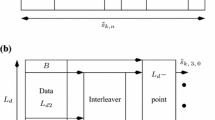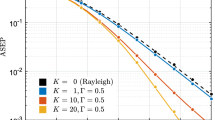Abstract
Coherent demodulation results in good detection performance but requires channel estimation. Fading pre-compensation (precoding) at the transmitter can lead to low-complex receiver structures with good performance capabilities, without the need for channel estimation. Time division duplex systems based on orthogonal frequency division multiplex (OFDM) are particularly suited to this because intersymbol interference effects can be neglected, simplifying transmitter adjustments. Methods that involve amplitude and/or phase pre-compensation are compared in terms of resulting bit error rate and increase in peak-to-average power ratio. Dynamic channels degrade the performance as the block lengths get longer. For a certain block length the performance degrades below that of traditional differential decoding. A block length of up to 40 times that used in the Digital European Cordless Telephone system, DECT, is possible using channel estimation and ideal Wiener prediction.
Similar content being viewed by others
References
A. Masoomzadeh-Fard and S. Pasupathy, “Combined Equalization and Differential Detection Using Precoding”, IEEE Transactions on Communications, Vol. 45, No. 3, pp. 274-278, 1997.
W. Zhuang and V. Huang, “Phase Pre-Coding for Frequency Selective Rayleigh and Ricean Slowly Fading Channels”, IEEE Transactions on Vehicular Technology, Vol. 46, No. 1, pp. 129-142, 1997.
H. Matsuki and H. Takanashi, “Theoretical Analysis of BER Improvement by Adaptive Transmitter Power Control for Rayleigh Fading Compensation”, Electronics Letters, Vol. 29, No. 17, pp. 1520-1521, 1993.
I. Ghauri and R. Knopp, “Power Control for Diversity Reception in Time-Division Duplex CDMA”, in Proc. of IEEE Vehicular Technology Conference, Ottawa, Canada, May 1998, pp. 2343-2347.
P.S. Henry and B.S. Glance, “A New Approach to High-Capacity Digital Mobile Radio”, The Bell System Technical Journal, Vol. 60, No. 8, pp. 1891-1904, 1981.
J.G. Proakis, Digital Communications (3rd edn), McGraw-Hill: New York, U.S.A., 1995.
European Telecommunications Standards Institute, “Broadband Radio Access Networks (BRAN); HIPERLAN type 2; Physical (PHY) Layer”, ETSI TS 101 475 V1.1.1, ETSI, Sophia Antipolis, France, 2000.
P. Hoeher, “TCM on Frequency-Selective Land-Mobile Fading Channels”, in Proc. 5th Tirrenia International Workshop in Digital Communication, Tirennia, Italy, Sept. 1991, pp. 317-328; E. Biglieri and M. Luise (eds), Coded Modulation and Bandwidth-Efficient Transmission, Elsevier Science Publishers: Amsterdam, the Netherlands, 1992.
J.D. Gibson (ed.), The Mobile Communications Handbook, CRC-Press: Boca Raton, FL, U.S.A., 1996.
Author information
Authors and Affiliations
Rights and permissions
About this article
Cite this article
Tufvesson, F., Faulkner, M. & Maseng, T. Pre-Compensation for Rayleigh Fading Channels in Time Division Duplex OFDM Systems. Wireless Personal Communications 16, 21–33 (2001). https://doi.org/10.1023/A:1026582404623
Issue Date:
DOI: https://doi.org/10.1023/A:1026582404623




